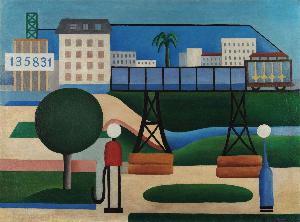Tarsila De Aguiar Do Amaral
Tarsila De Aguiar Do Amaral;Tarsila Do Amaral
สถานที่: Capivari
เกิด: 1886
ความตาย: 1973
ชีวประวัติ:
Early Life and Training
Tarsila De Aguiar Do Amaral, a renowned Brazilian painter, draftswoman, and translator, was born on September 1, 1886, in São Paulo, Brazil. She belonged to a wealthy family of coffee producers and was raised in an environment that encouraged her artistic pursuits. Tarsila's early training included studying under Pedro Alexandrino Borges before moving to Paris in 1920 to enroll in the Académie Julian and later the Académie Moderne, where she was influenced by Fernand Léger, Albert Gleizes, and André Lhote.
Contribution to Brazilian Modernism
Tarsila is considered one of the leading figures in defining a Brazilian modernist tradition. Her work played a pivotal role in shaping the country's artistic identity. As a member of Grupo dos Cinco, alongside Anita Malfatti, Menotti Del Picchia, Mário de Andrade, and Oswald de Andrade, Tarsila significantly influenced the modern art movement in Brazil.
Notable Works and Aesthetic Movement
* Abaporu (1928), a celebrated painting, inspired Oswald de Andrade's famous Manifesto Antropófago, a cornerstone of the aesthetic movement Antropofagia. * A Negra (1923), an early work, showcases Tarsila's emerging style. * Morro da Favela, a piece that reflects her engagement with Brazilian themes.
Museums and Collections Featuring Her Work
* Museu de Valores do Banco Central do Brasil (Brasília, Brazil) houses several of Tarsila's works, including Antropofagic landscape with ox and Study (Nude - Figure from the hips up). * The Museu de Arte do Rio Grande do Sul Ado Malagoli (Porto Alegre, Brazil), while not exclusively featuring Tarsila's work, represents the broader context of Brazilian art.
- View Tarsila De Aguiar Do Amaral's artworks on Wikioo.org: Tarsila De Aguiar Do Amaral | Wikioo.org
- Explore the artist's biography and works on Wikipedia: Tarsila do Amaral — Wikipédia
- Discover more about Brazilian Modernism and Tarsila's role in it through Wikioo.org's collection: Museu de Arte do Rio Grande do Sul Ado Malagoli (Porto Alegre, Brazil)
* Born: September 1, 1886 * Died: January 17, 1973 * Notable Movement: Brazilian Modernism, Antropofagia














